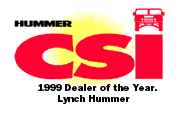|
H2'S PREMIUM POWERTRAIN ANCHORED BY VORTEC POWER
AND SOPHISTICATED FOUR-WHEEL DRIVE
The HUMMER H2 combines class-leading Vortec power with a durable
four-speed automatic transmission and a sophisticated four-wheel-drive
system to stake its claim to being a true go-anywhere vehicle.

"H2 provides excellent on-pavement power, performance
and control for everyday driving and routine tasks like trailer
towing," said Ken Lindensmith, H2 assistant vehicle line
executive. "But its true character really shines in the
off-road arena. It can easily soldier over rocks and through
the harshest terrain."
H2 can safely charge into six inches of water at 40 mph, for
example, or travel through streams more than 20 inches deep at
a leisurely 5-mph pace. It can also comfortably and confidently
climb 16-inch steps and rocks, without getting hung up or jarring
its passengers. And it can paddle through deep sand or run over
sandy surfaces in high-speed desert conditions with remarkable
ease.
It's powered by a standard GM Vortec 6000 6.0-liter V8 producing
325 horsepower at 5200 rpm and 385 lb.-ft. of torque at 3600
rpm. The engine is mated to a heavy-duty 4L65-E four-speed automatic
transmission, capable of out-muscling and out-torquing H2's premium
off-road competitors. The H2's powertrain, aided by the 4L65-E's
deep 3.06 first gear ratio, provides smooth launches and respectable
off-line acceleration for a vehicle of its size and strength.

The engine uses a new Hitachi throttle body as part of its
precise electronic throttle control (ETC) system. ETC, a drive-by-wire
system, provides a highly sophisticated and comprehensive way
of controlling throttle position. In addition to information
from the accelerator pedal, H2's ETC system also considers other
available information, such as transmission shift schedules and
whether the vehicle's transfer case is in "4 HI" or
"4 LO" operating mode, to determine the optimum throttle
progression for different operating requirements.
The sophisticated four-wheel-drive system and transfer case
are versatile and driver-selectable. The integrated Borg-Warner
two-speed electrically controlled full-time 4WD system is capable
of further reducing the vehicle's gear ratios by 2.64:1 when
necessary, for highly controlled obstacle climbing. It provides
a 40/60 percent front-to-rear torque split in "High Open"
mode or when the differentials are unlocked and a 50/50 percent
front-to-rear power split when the transfer case differential
is locked. A specially designed low-range throttle progression
allows the driver to precisely control engine speed (and as a
result, the vehicle) during very rough terrain driving, and is
automatically engaged when the transfer case is in "4 LO."
The transfer case controls provide five mode selections, four
of which can be accessed by dash-mounted button selectors. The
fifth mode, neutral, is available by simultaneously pressing
two of the button selectors. Selections include:
1) A high-range open or "4 HI Open" for normal,
everyday driving on dry road surfaces at any speeds.
2) A high-range lock or "4 HI Locked" for semi-slippery
surfaces like snow, light sand or wet areas, such as those around
a boat launch; this selection locks the front and rear output
shafts together, so their wheels rotate at exactly the same speed.
3) A low-range lock or "4 LO Locked" for severe
off-pavement use, such as crawling over large rocks or logs.
In addition to locking the two propshafts together, it provides
a 2.64:1 gear reduction in the planetary gearset. By lowering
the ratios of each of the gears, it adds the equivalent of another,
extremely deep-ratio first gear and provides a great deal more
torque for slow-speed climbing. Low Lock also activates a new,
more measured throttle progression curve, which greatly enhances
off-road driving comfort and control. High and Low Lock also
allow a driver to select a different set of calibrations for
the traction control system, using a separate "TC2"
button. This provides additional wheel slip for select operating
conditions and road surfaces, such as paddling through deep sand.
4) An Eaton electronic rear differential lock or "4 LO
Locked + Rear Diff Locked," available only when the transfer
case is in Low Lock position. It permits locking up the rear
differential for optimum slow-speed capability in climbing over
large rocks or up long, steep grades. It locks the two rear axle
shafts together so they rotate at exactly the same speed-and
does so electronically. (Since this mode can only be accessed
when the transfer case is in Low Lock, the front and rear propshafts
are already locked.)
5) "Neutral," obtained by simultaneously pressing
the "4 LO Locked" and "4 HI Open" buttons
and holding them down for 10 seconds. It permits flat-towing
the H2 behind another vehicle.

The H2 provides two different throttle progressions, depending
on whether it is operating on pavement or off. With the transfer
case either in a High Open or High Lock mode, the driver gets
normal acceleration for everyday city and highway requirements.
The "tow-haul" mode switch is available in either of
these driving modes. This allows for a different shift progression
of the transmission more suitable to trailering operation. However,
off-road operation requires a slower, more controlled throttle
response. Large-rock and obstacle crawling, in particular, demand
both high torque and a very slow, carefully controlled vehicle
speed, with no sudden movement.
When the driver shifts into Low Lock, the H2's low-range throttle
progression provides required responsiveness and control. With
the new throttle progression curve (calibrated into the electronic
engine controller) that it creates, a driver can step on the
accelerator without opening up the throttle plate as quickly
or fully. At maximum throttle depression, for example, the throttle
plate only opens up to about 75 percent of its normal capability.
And it takes longer, more throttle travel, to get to that 75
percent maximum, so power or torque are delivered in a more measured
and controlled manner.
Adding to the overall sense of control is a highly developed
Bosch four-channel antilock braking/traction control system (ABS/TCS).
In addition to providing optimum control on slippery surfaces,
the ABS can detect and adjust its braking capabilities to rough
off-road surfaces like gravel and potholes. The TCS also provides
the ability to gain traction through a single wheel, if necessary.
A second mode of the TCS system, "TC2," used in conjunction
with the transfer case's selections, provides three additional
operating modes: "4 HI Locked + TC2," "4 LO Locked
+ TC2" and "4 LO Locked + Rear Diff Locked + TC2."
This provides distinct advantages in different driving conditions,
such as loose sand or gravel in the desert or mud or slippery
conditions.
The H2's ABS is uniquely designed to detect rough-road surfaces
and respond accordingly in addition to providing normal on-road
control on slick surfaces. The ABS has separate control logic
schemes to discern and react to deformable surfaces and provide
the best solution for braking. As a result, the driver is frequently
not aware that the ABS system is engaged, just feeling the sensation
of a smooth responsive stop. In a very loose gravel surface,
the driver may recognize added pedal travel during the stop,
when the system has determined that more braking force is the
correct solution. The result is an approximate 50 percent increase
in deceleration on this surface condition.
The Single Wheel traction control system provides additional
capability under certain operating conditions. The system detects
a slipping wheel and applies brake pressure to it to slow it
down, transferring torque across the differential to provide
traction for the wheel on the opposite side. The system senses
any slipping wheels and applies the brakes to them individually,
while the driveline and differentials transfer torque to the
wheel with the high traction for added traction. A driver could
have as many as three wheels on a slippery surface with virtually
no traction and still get enough torque out of the fourth wheel
to propel the truck up a 10 percent grade.
Whenever the transfer case is in any locked mode, such as
High Lock, Low Lock or Low Lock and Rear Differential Lock, a
second selection, called "TC2," is available. The "TC2"
button, as indicated, is on the dash in a separate block of controls
just below the transfer case selections. TC2 frees the TCS up
to provide more wheel slip on loose or deformable road surfaces
like sand, where a driver typically needs to "paddle"
through. Here, the vehicle might be going 10 mph, for example,
while the wheels are spinning at 20 mph.
With three transfer case selections, two rear axle differential
selections and two modes provided by the TCS mode switch, the
driver actually has total of seven driving mode selections, providing
unprecedented versatility to tailor H2 performance to match driving
conditions.
|



